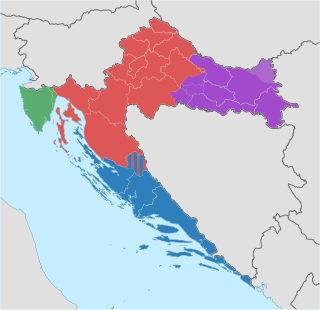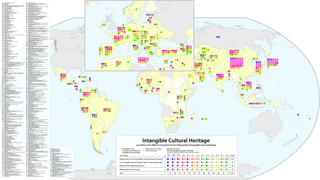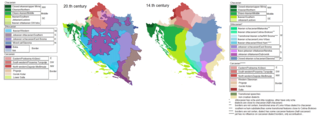
Dalmatia is one of the four historical regions of Croatia, alongside Central Croatia, Slavonia, and Istria, located on the east shore of the Adriatic Sea in Croatia.
Bunjevci are a South Slavic sub-ethnic group of Croats living mostly in the Bačka area of northern Serbia and southern Hungary, particularly in Baja and surroundings, in Croatia, and in Bosnia-Herzegovina. They presumably originate from western Herzegovina. As a result of the Ottoman conquest, some of them migrated to Dalmatia, from there to Lika and the Croatian Littoral, and in the 17th century to the Bácska area of Hungary.
The gusle or lahuta is a bowed single-stringed musical instrument traditionally used in the Dinarides region of Southeastern Europe. The instrument is always accompanied by singing; musical folklore, specifically epic poetry. The gusle player holds the instrument vertically between the knees, with the left hand fingers on the string. The string is never pressed to the neck, giving a harmonic and unique sound.

Lika is a traditional region of Croatia proper, roughly bound by the Velebit mountain from the southwest and the Plješevica mountain from the northeast. On the north-west end Lika is bounded by Ogulin-Plaški basin, and on the south-east by the Malovan pass. Today most of the territory of Lika is part of Lika-Senj County. Josipdol, Plaški and Saborsko are part of Karlovac County and Gračac is part of Zadar County.

Split-Dalmatia County is a central-southern Dalmatian county in Croatia. The administrative center is Split. The population of the county is 455,242 (2011). The land area is 4.540 km2, the total area is 14.106,40 km2. Split-Dalmatia County is Croatia's most rapidly urbanising and developing region, as economic opportunities and living standards are among the highest alongside capital Zagreb and Istria County.

Kochari is a folk dance originating in the Armenian Highlands. It is performed today by Armenians, while variants are performed by Assyrians, Azerbaijanis, and Pontic Greeks. It is a form of circle dance.

Croatian cuisine is heterogeneous and is known as a cuisine of the regions, since every region of Croatia has its own distinct culinary tradition. Its roots date back to ancient times. The differences in the selection of foodstuffs and forms of cooking are most notable between those in mainland and those in coastal regions. Mainland cuisine is more characterized by Slavic features and influences from the more recent contacts with Turkish, Hungarian and Austrian cuisine, using lard for cooking, and spices such as black pepper, paprika, and garlic. The coastal region bears the influences of Greek and Roman cuisine, as well as of the later Mediterranean cuisine, in particular Italian. Coastal cuisines use olive oil, herbs and spices such as rosemary, sage, bay leaf, oregano, marjoram, cinnamon, clove, nutmeg, and lemon and orange rind. Peasant cooking traditions are based on imaginative variations of several basic ingredients and cooking procedures, while bourgeois cuisine involves more complicated procedures and use of selected herbs and spices. Charcuterie is part of the Croatian culinary tradition in all regions. Food and recipes from other former Yugoslav countries are also popular in Croatia.

Klapa music is a form of traditional a cappella singing with origins in Dalmatia, Croatia. The word klapa translates as "a group of friends" and traces its roots to littoral church singing. The motifs in general celebrate love, wine (grapes), country (homeland) and sea. Main elements of the music are harmony and melody, with rhythm very rarely being very important. In 2008, Croatian Ministry of Culture proclaimed it Croatian Intangible Cultural Heritage. In 2012 klapa was inscribed in UNESCO Intangible Cultural Heritage of Humanity.
Ganga is a type of singing that originated from rural Dinaric mountain region. It is most commonly found in the regions of Herzegovina and Dalmatia, but it can also be found to an extent in western Bosnia, Lika, Kordun and rural areas of north-west Montenegro. It is characterized by a lone singer singing a single line of lyrics, followed by others joining in, using a vocal style that is best described as a wail.

Though the Republic of Croatia administratively consists of twenty counties, it is traditionally divided into four historical and cultural regions: Croatia proper, Dalmatia, Istria, and Slavonia. These are further divided into other, smaller regions.

In contemporary geography, the terms Central Croatia and Mountainous Croatia are used to describe most of the area sometimes historically known as Croatia or Croatia proper, one of the four historical regions of the Republic of Croatia, together with Dalmatia, Istria, and Slavonia. It is located between Slavonia in the east, the Adriatic Sea in the west, and Dalmatia to the south. The region is not officially defined, and its borders and extent are described differently by various sources. The term Central Croatia refers to the northeastern part, and the term Mountainous Croatia refers to the southwestern part of the territory; the far western part is known as the Croatian Littoral; likewise the terms 'Zagreb macroregion' and 'Rijeka macroregion' can be used instead. Central Croatia is the most significant economic area of the country, contributing well over 50% of Croatia's gross domestic product. The capital of the Republic of Croatia, Zagreb, is the largest city and most important economic centre in Central Croatia.

The Croatian National Guard was an armed force established by Croatia in April and May 1991 during the Croatian War of Independence. Although it was established within the framework of the Ministry of the Interior for legal reasons, the ZNG was under the direct command of the Ministry of Defence. It was tasked with the protection of Croatia's borders and territory, and with tasks normally associated with police forces. The ZNG was formed with the transfer of special police units to the ZNG, establishing four all-professional brigades in May 1991, and was presented to the public in a military parade in Zagreb on 28 May. It was commanded by Defence Minister General Martin Špegelj before his resignation in early August. Špegelj was replaced by General Anton Tus, who became the first head of the General Staff of the Armed Forces of the Republic of Croatia.

The Lika cap, also known as kićanka ("tassel") or crvenkapa, is an important cultural symbol of the Lika region in Croatia, part of the Lika national costume traditionally worn by local Croats and Serbs. It is cylinder-shaped, with a flat top in a red colour, black sides, and often with a black tassel in the back.

UNESCO established its Lists of Intangible Cultural Heritage with the aim of ensuring better protection of important intangible cultural heritages worldwide and the awareness of their significance. This list is published by the Intergovernmental Committee for the Safeguarding of Intangible Cultural Heritage, the members of which are elected by State Parties meeting in a General Assembly. Through a compendium of the different oral and intangible treasures of humankind worldwide, the programme aims to draw attention to the importance of safeguarding intangible heritage, which UNESCO has identified as an essential component and as a repository of cultural diversity and of creative expression.
Croatian dance traditionally refers to a category of folk-dances, the most common being the kolo.

Croatian national costume, also called as Croatian traditional clothing or Croatian dress, refers to the traditional clothing worn by Croats living in Croatia, Bosnia and Herzegovina, Serbia, with smaller communities in Hungary, Austria, Montenegro, and Romania. Since today Croats wear Western-style clothing on a daily basis, the national costumes are most often worn with connection to special events and celebrations, mostly at ethnic festivals, religious holidays, weddings, and by dancing groups who dance the traditional Croatian kolo, or circle dance.
The Register of Cultural Goods of the Republic of Croatia has been established in 1999. The Croatian Ministry of Culture is responsible for the administration of this public register, which has been created according to the Act on the protection and preservation of cultural goods of 1999. The register is a comprehensive list of all cultural monuments under national protection.

Younger Ikavian, also called Western Ikavian/Western Neoshtokavian Ikavian, or Bosnian–Dalmatian dialect, is a subdialect of Shtokavian Serbo-Croatian spoken primarily by Croats in Croatia, Bosnia and Herzegovina, Serbia, and Italy. It is spoken to a lesser extent by Bosniaks and rarely by Serbs in Bosnia and Herzegovina. Most speakers use the Latin alphabet.
The term Vlachs was initially used in medieval Croatian and Venetian history for a Romance-speaking pastoralist community, called "Vlachs" and "Morlachs", inhabiting the mountains and lands of the Croatian Kingdom and the Republic of Venice from the early 14th century. By the end of the 15th century they were highly assimilated with the Slavs and lost their language or were at least bilingual, while some communities managed to preserve and continue to speak their language (Istro-Romanians).
Atanasije Ljubojević or Ljubović was the Serbian Orthodox Metropolitan of Dabar-Bosnia from 1681, and then the bishop of the Orthodox Serbs in the Venetian areas in the Dalmatian hinterland and the Habsburg areas in Gornja Krajina. He is recorded in history as the only diocesan archbishop from the time of the renewed Serbian Patriarchate (1557-1766) who performed the diocesan service under Turkish, Venetian and Habsburg rule.














